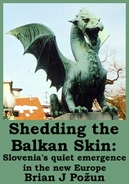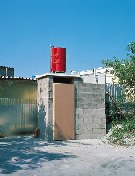Over the centuries, Slovenia has developed a vibrant and idiosyncratic artistic culture. The country has deep-rooted folk traditions but has also been influenced by all of the major European artistic movements, as a result of its longstanding position in the Austrian Empire. The synthesis of these two streams has created an artistic culture that is uniquely Slovene.
Perhaps the most internationally known Slovene artists are the architect Jože Plečnik and the band Laibach, but even they have not achieved substantial international renown.
Two exhibits, currently open in New York City, will hopefully begin to pull Slovene art out of the shadows: Kagiso: Skeleton House, at the Guggenheim Museum, and Body and the East, an exhibit of the Moderna Galerija Ljubljana, at Exit Art Gallery in SoHo.
At the Guggenheim: Marjetica Potrč
Tuesday 8 February was Slovenia's National Day of Culture. Events marking this date were celebrated not only in Slovenia, but also in the United States. In New York, the first Slovene one-woman show exhibited at the Guggenheim Museum was having a gala opening reception. Though the reception was invitation-only, between1000 to 3000 guests attended, including Slovenia's Permanent Representative to the United Nations Ernest Petrič.
Open from 9 February to 29 April, the exhibit Kagiso: Skeleton House, is small but impressive. Last summer, Marjetica Potrč was awarded the Hugo Boss Prize 2000, a biennial award given for achievement in contemporary art sponsored by Hugo Boss and the Guggenheim. Aside from the USD 50,000 prize, Potrč also won the chance to stage this groundbreaking show.
The first Hugh Boss Prize was given to American artist Matthew Barney in 1996 and the second to Scottish artist Douglas Gordon in 1998. Over 50 artists were nominated in 2000, and the top seven made it to the shortlist. An international jury of curators and museum directors chose Potrč as the winner last fall.
Urban anthropology
Potrč was born in 1953 in Ljubljana and holds degrees in architecture and fine arts. Her current exhibit is clearly influenced by both of these interests, yet, offers more than a sum of these two parts. Instead, the exhibit displays an intersection of sculpture, photography, architecture and writing.
Commenting on the complex framework within which she creates her work, Potrč told the Slovene daily Dnevnik: "Lately, I see myself as an anthropologist who works with the contemporary city. In my work I expose the value and interconnections within the global city which are expressions of contemporary times."
In such diverse cities as Johannesburg, Hong Kong, New York and Ljubljana, Potrč sees common threads, especially among the urban poor. She told Dnevnik that every three days, another million people move into cities, and it is the innovative ways in which they create housing for themselves in shantytowns that catch her attention.
Potrč revels in the creative spirit expressed by the urban poor who are unwilling to move into government housing projects, because their personalized, oftentimes homemade, dwellings in the shantytowns are more of a "home" than the projects' cookie-cutter dwellings.
Kagiso: skeleton house
Potrč's exhibit offers an eclectic mix of objects. The centerpieces are two architectural structures that were inspired by a South African family. The South African government offers the poor a sort of subsidized housing, which includes a floor, a roof and a toilet. It is up to the new owners to devise the rest. One family moved their shanty piece-by-piece to the site of this unfinished "house" so that they could guard its prize, the toilet, which is frequently a target of theft.
Potrč recreated this story for her exhibit, by installing one of these South African "skeleton houses," alongside a self-made shanty of found objects. Apart from the structures, the exhibit also includes more than a dozen photographs of urban, primarily poverty-stricken, areas with text of the artist's comments and insights.
One of two other objects on display is a cast-off bombshell from Sarajevo, which has been recreated as a vase. The work is called "This then That," because first it was a weapon to kill or maim, but now it is a piece of art that "touches the soul."
The second object is a wearable computer, a super high-tech device that stands in strange counterpoint to the images of urban poverty surrounding it.
SoHo: Body and the East
A second exhibit offering Slovene art can be found at the Exit Art Gallery in New York's art-rich SoHo neighborhood. Body and the East: from the 1960s to the Present will be open from 20 January until 10 March. The exhibit was inaugurated in 1998 at the Moderna Galerija Ljubljana, one of the leading institutions of contemporary art in Slovenia, and is curated by the Moderna's director, Zdenka Badovinac.
While the exhibit was organized in Slovenia, it does not concentrate exclusively on Slovene art. Instead, the exhibit includes work from eighty artists and collectives from fourteen post-Communist countries (Bulgaria, Bosnia and Herzegovina, the Czech Republic, Croatia, Yugoslavia, Lithuania, Hungary, Moldova, the former German Democratic Republic, Poland, Romania, Russia, Slovakia and Slovenia).
The exhibit is built around thirty monitors showing videos of performances, accompanied by still photographs. Exit Art Gallery also organized an impressive program in conjunction with the exhibit, including performances by Peter Mlekar and Slaven Tolj, both of whom are featured artists. In addition, a five-week "Balkan Cabaret" concert series is also underway It lasts until 2 March.
The body behind the Iron Curtain
The exhibit, Body and the East, concentrates on "body art," a diverse range of practices that place the artist's body as the focal point of the work. Performance art in Central and Eastern Europe under Communism was difficult, since the authorities were not known for their tolerance of non-conformist creativity or thinking. Many artists who took their performances to the street ended up in jail. As a result, most of the performances in this exhibit were done in private homes, behind closed doors.
The marginalization of non-conformist artists in the region ironically had the opposite effect, bringing about a flowering of unofficial art in many countries. However, the marginal place of the artists and their work in their home countries often meant even greater obscurity abroad. Body and the East, therefore, offers a truly unique insight into the modes of creative expression behind the Iron Curtain, which until now have been known to only a select few on either side.
Highlights from Slovenia
Body artists could primarily be found in the major urban centers of the former Yugoslavia, including Zagreb, Belgrade and Ljubljana. Ljubljana, in particular, was a magnet due in no small part to its reputation as the most liberal of Yugoslavia's cities. As a result, much of the work exhibited had been previously performed in Slovenia by artists from across Central and Eastern Europe.
The Slovenes are well represented in Body and the East. One of Slovenia's most important contemporary bands, Laibach, is represented in the exhibit by three posters and the film Laibach: A Film from Slovenia. The band shocked Yugoslav audiences by adopting Nazi symbols and performing in German. Despite this, however, Laibach was able to attract a wide following throughout the former country.
The band is part of a larger collective, known as Neue Slowenische Kunst, or NSK. Peter Mlekar, a member of another branch of the NSK (the Department of Pure and Applied Philosophy), is presented in the exhibit as well. A video, on continuous loop in the gallery, shows Mlekar reading a lecture called "The Continence of God and German Sexual Discipline," while accompanied by two prostitutes.
A video of Tomaž Šalamun and the Slovene collective OHO from 1969 is also included in the exhibit. Šalamun was filmed walking from Novi Sad's Tribina Mladih Gallery to the Petrovaradino Fortress. He is shown dragging a piece of chalk fastened to a stick behind him, which is drawing a continuous line.
New faces in New York
It should prove significant for the Slovene arts that these two exhibits, Kagiso: Skeleton House and Body and the East, are being featured in New York, the self-proclaimed cultural capital of the world. The shows have met with acclaim by both Americans and Slovenes.
Marjetica Potrč's one-woman show could hardly have hoped for a more prominent and internationally renowned museum than the Guggenheim. The curator of the Moderna Galerija Igor Zabel, commenting in Dnevnik, compared the one-woman show at the Guggenheim to a solo performance at the Met. The body art of Body and the East and the SoHo hipsters are also proving to be a perfect match.
The Slovenes perhaps have not made such an organized splash on the New York arts scene as the Slovaks (www.slovakculture.com], but this pair of exhibits should take little-known Slovene artists a few steps closer to international prominence.
Brian J Požun, 16 February 2001

Brian J Požun's new ebook now on sale from CER |
Moving on:
- Archived articles about Slovene culture in CER
- Archive of Brian J Požun's articles in CER
- Browse through the CER eBookstore for electronic books
- Buy English-language books on Central and Eastern Europe through CER
- Return to CER front page
Publications:
In conjunction with this year's HUGO BOSS PRIZE, the Guggenheim has published a catalogue that features the work of all seven finalists. The catalogue is available for $19.95.Body and the East: From the 1960s to the Present; by Zdenka Badovinac (Editor), Mika Briski (Editor), Moderna Galerija. Bilingual (Slovenian/English).
Sources:
Guggenheim Museum
Marjetica Potrč
exit art
Moderna Galerija
Laibach
NSK Department of Pure and Practical Philosophy
Inke Arns, Impressions from Ljubljana




